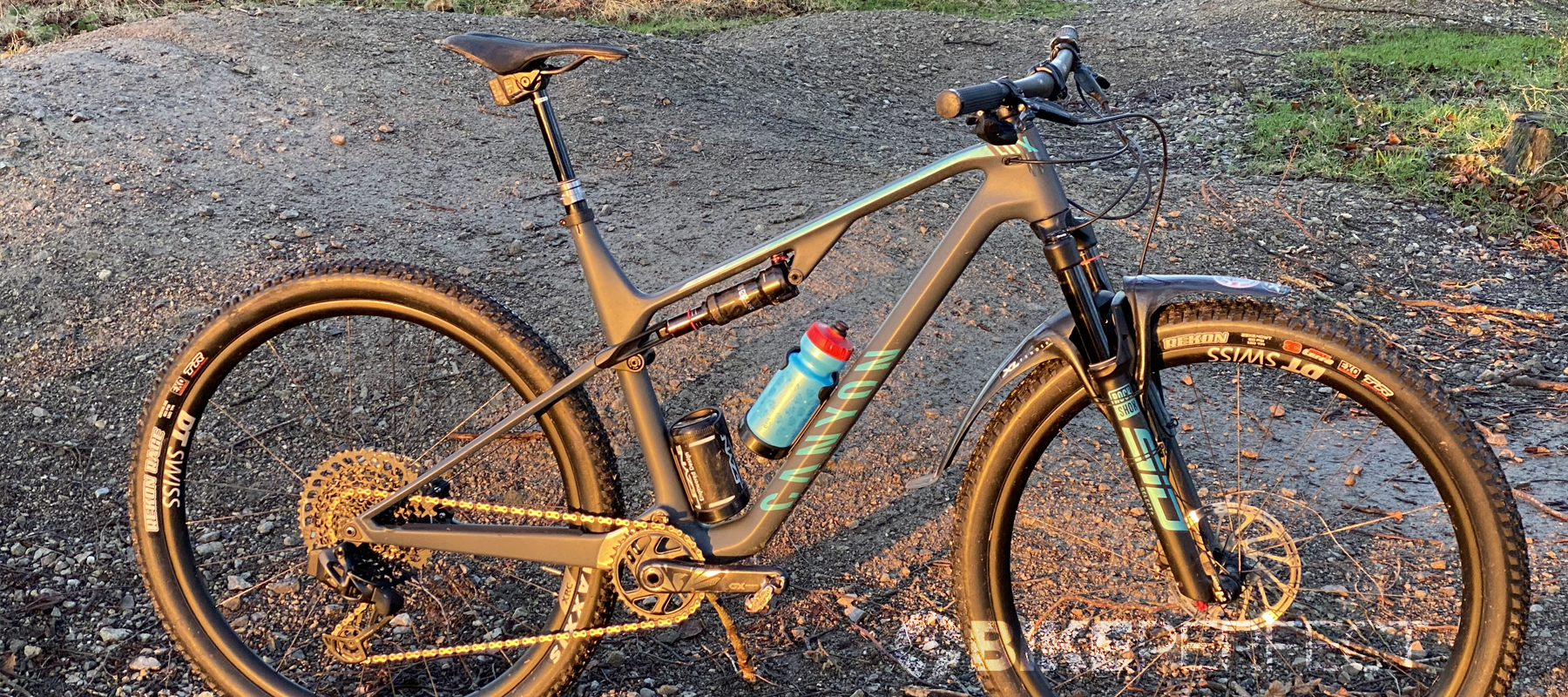Bike Perfect Verdict
Canyon’s Lux Trail looks like a brilliant value, state of the art ‘downcountry’ bike on paper, but awkward frame proportions and fundamentally flawed suspension are disappointingly dated on the trail
Pros
- +
Excellent AXS wireless component spec for the money
- +
Benchmark DT Swiss carbon wheel and Maxxis tire team
- +
Combined suspension lockout
- +
Stretched straight-line stability
- +
Double big bottle space
- +
Super neat chain keeper
- +
Tidy steering lock stopper
- +
Tool free wheel removal
Cons
- -
Under leveraged shock is too stiff
- -
Overly linear suspension feel once moving
- -
Tangible power loss when pedaling
- -
Excessive seat tube height restricts size options
- -
Long reach needs a shorter stem/steeper seat angle
- -
Harsh bar feel
- -
Direct buy only
Why trust BikePerfect
Thanks to riders like Mathieu Van Der Poel and Pauline Ferrand-Prevot, Canyon’s Lux race bike has had an impressive career on the World Cup XCO circuit. The Koblenz firm has matched that proven back end to a new longer, slacker ‘trail’ front end with some really neat features. Add 10mm of rear travel and 20mm of fork stroke, a full SRAM AXS set up including seatpost, plus DT Swiss carbon wheels and it looks like a total ‘downcountry’ bargain.
Even if you modify the awkward default handling balance, fundamentally flawed suspension means it’s more of a straight-line marathon smasher than a tech trail player when pitted against the best full-suspension mountain bikes.
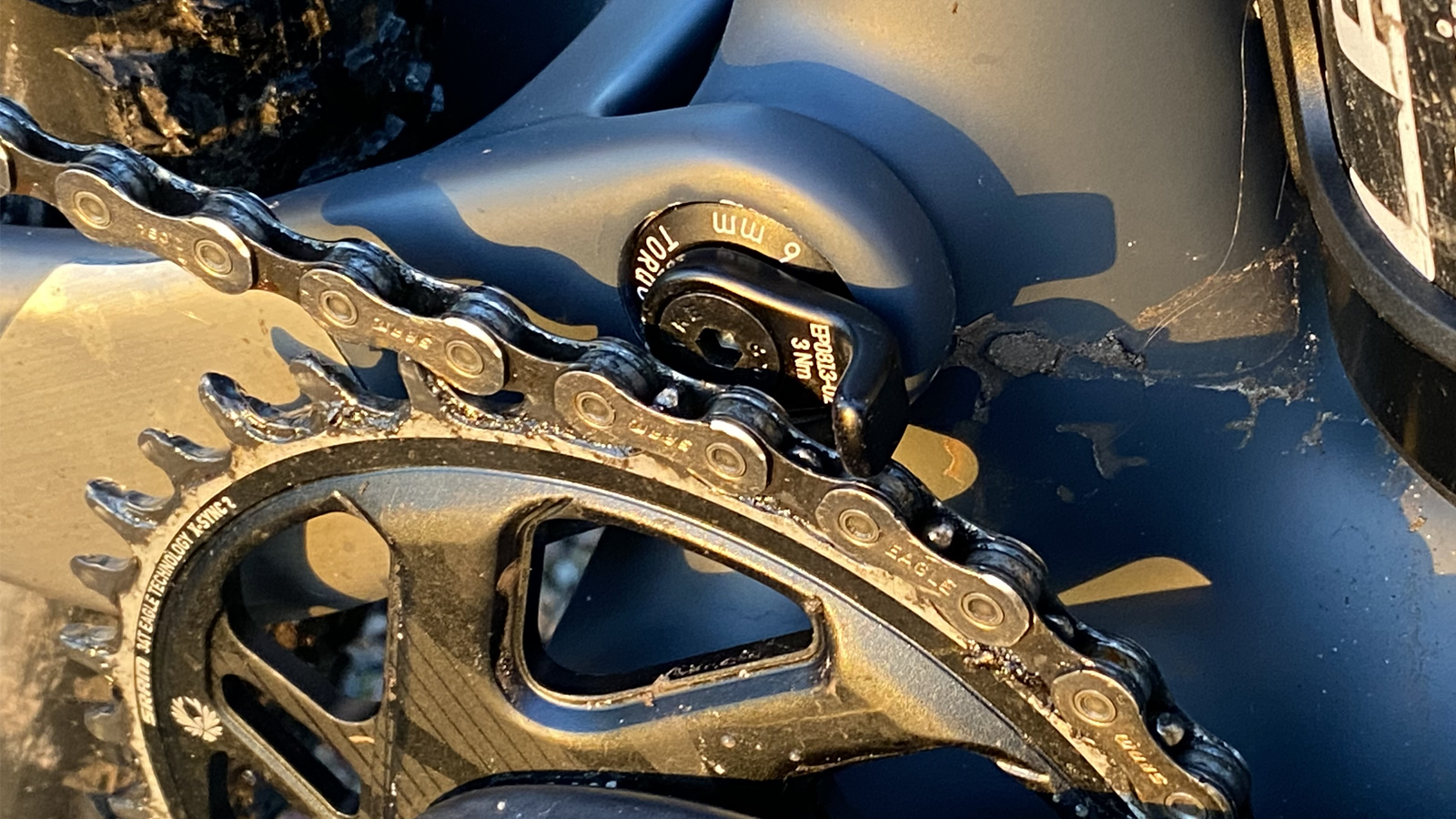
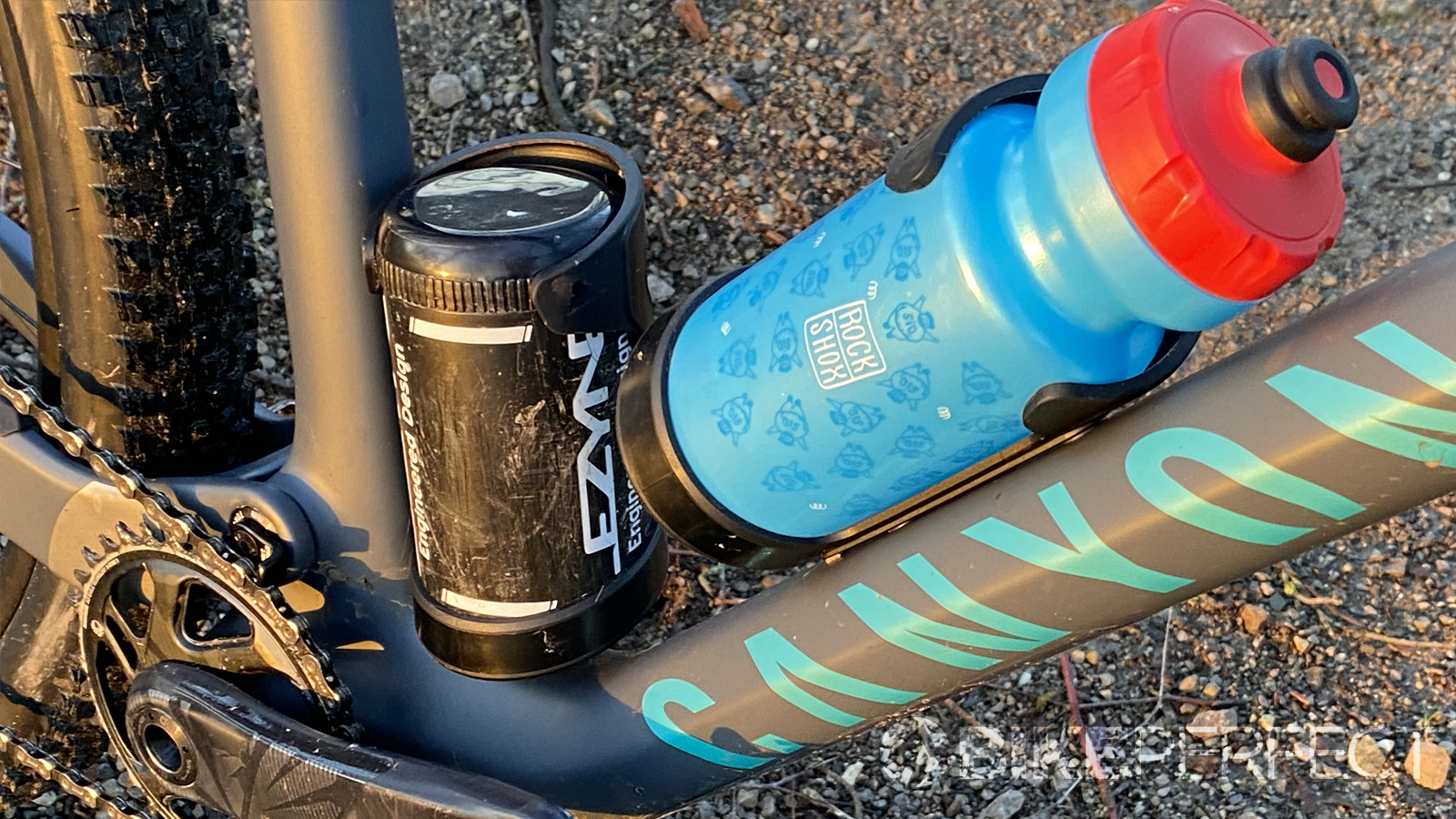
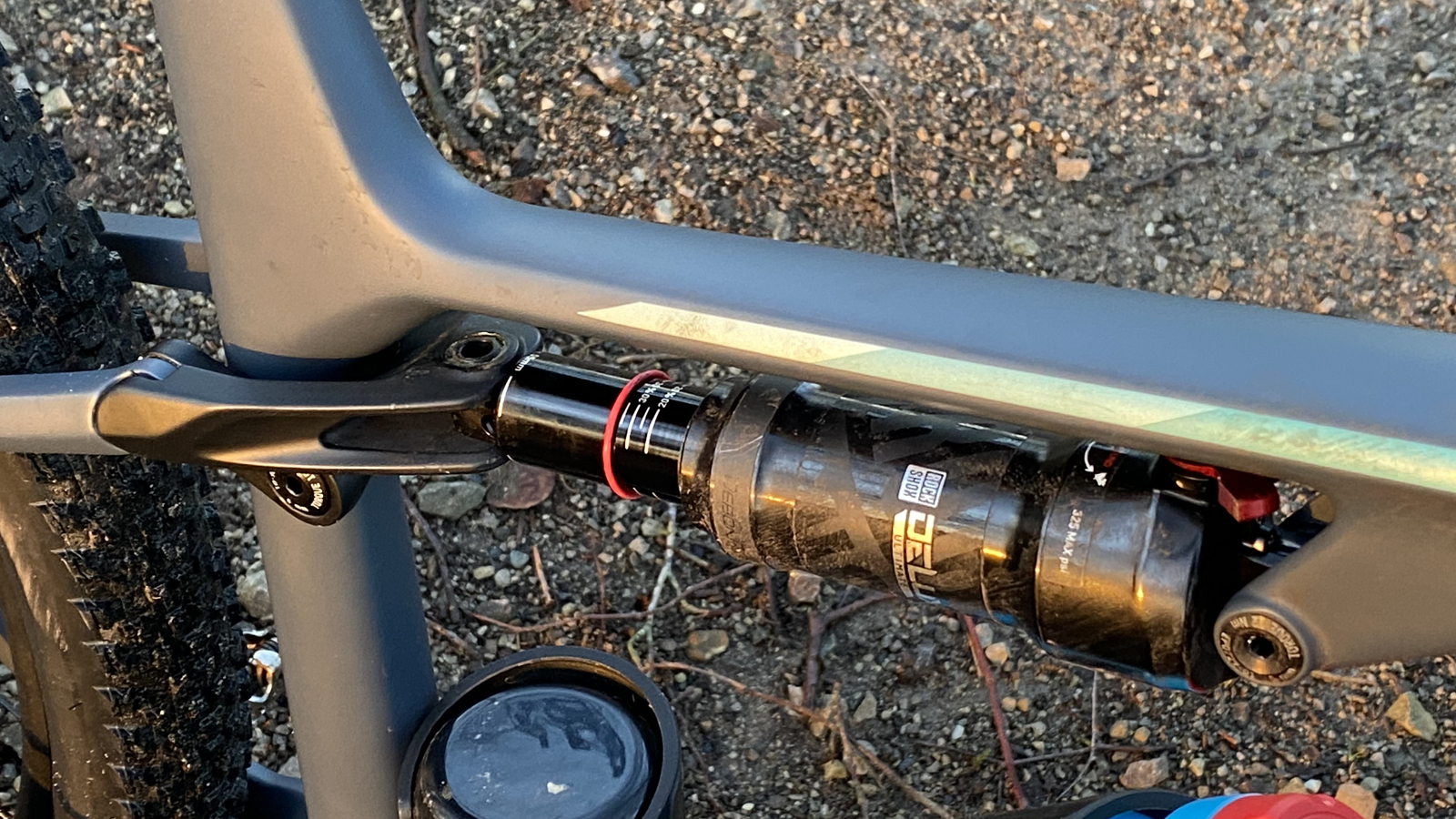
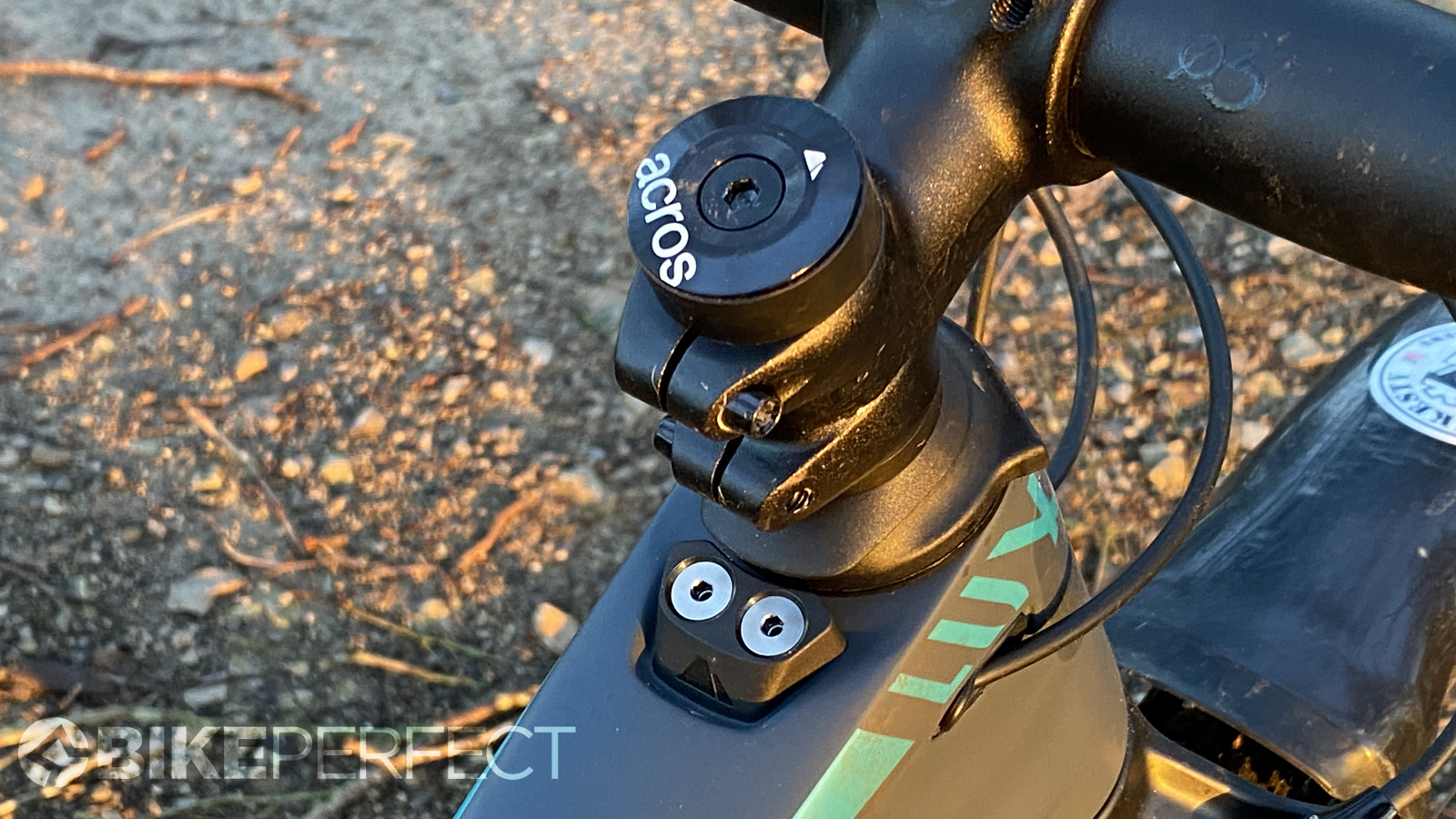
Design and geometry
The Lux Trail mainframe follows the established Lux layout but geometry is significantly altered at the front end. A 30mm increase in reach took our large sample out to 480mm, the head angle is relaxed to 67.5-degrees (from 69.5-degrees) too. The extended mast seat tube is still 508mm long though and it’s only 0.5-degree steeper at 74.5 degrees.
Detailing is typically neat for Canyon though and includes quiet cable routing, room for two large bottle cages and a super neat chain keeper tab (8.7g with bolt) threaded into the main pivot. A removable steering lock chuck on the top tube stops the shifters from hitting the top tube in a crash if you run the stem flipped down.
Slightly altered dimensions for the short linkage suspension set-up pump 110mm of rear wheel movement out of the long RockShox Deluxe Ultimate shock which lies parallel with the top tube. Otherwise, the 435mm back end is the same as the Lux XC bike with tapered seat stays providing enough flex to remove the need for a physical pivot. A pull-out ‘Quixle’ lever in the rear axle makes wheel removal easy and you get a road bike style Flat Mount for the rear Level TLM brake.
A molded chain protector and metal gouge guards on the chainstay add rowdy terrain protection. They’re still using a press-fit bottom bracket though so keep your eye on any wear or movement from that before it migrates into the frame. While we’ve not stripped it down to check, Canyon’s fully itemized breakdown (right down to the decal weight which ironically shows the team spec color weighs 75g more than standard) claims an 1895g frame weight without shock. There’s currently no premium carbon fiber option like there is with the Lux SLX and the 140/130mm travel Neuron SLX trail/tour bike and Spectral CFR 160/150mm trail/enduro bike.
Components and build
The CF8 is the flagship Lux Trail of a three bike range and there’s no doubting that the full suite of SRAM GX AXS wireless componentry is the big news here. It really is the full set too, including the premium Reverb AXS seatpost which most brands miss off their ‘AXS’ bikes.
The chainset is the carbon armed version too, with a 34T ring for cranking out extra speed and while the chain is a cheeky NX spec downgrade it’s hardly a deal-breaker. You also get a set of the excellent, light but tough DT Swiss XRC 1501 Spline 30mm carbon rimmed wheels with a MaxxTerra triple compound Maxxis Rekon tire up front and a dual compound Rekon Race out back.
While you might expect a lightweight SIDLuxe shock on an XC categorized bike it’s not available in the super long 55mm stroke the Lux and Lux Trail use so you get the 30-percent heavier Monarch Ultimate Remote. The SID front fork is the Select+ version with the simpler, heavier Charger 2 damper but usefully stiff 35mm legs, SKF seals and Maxima Plush fluid are the same. A Maxle QR lever for the 15mm axle combines with the Quixle rear for easy, tool-free wheel removal/replacement.
Canyon’s cold forged 60mm stem is a decent piece that leaves the basic Race Face Ride alloy 10mm ‘riser’ bar as the only obvious ‘meh’ in the component mix. At 12.15kg the overall weight is higher than we expected given the spec and claimed frame weight.
The price for spec is still undeniably excellent though and if you’re more into weight than wireless tech you’ve also got the option of the $5,299 / £4,200 XT equipped CF7 which is only 100g heavier or the $3,999 / £3,200 CF6 which is 300g heavier with SLX and a Fox Stepcast 34. You have got to remember that you’ll be getting your Canyon in a very nice box with essential tools included direct to your door, not buying it from a shop.
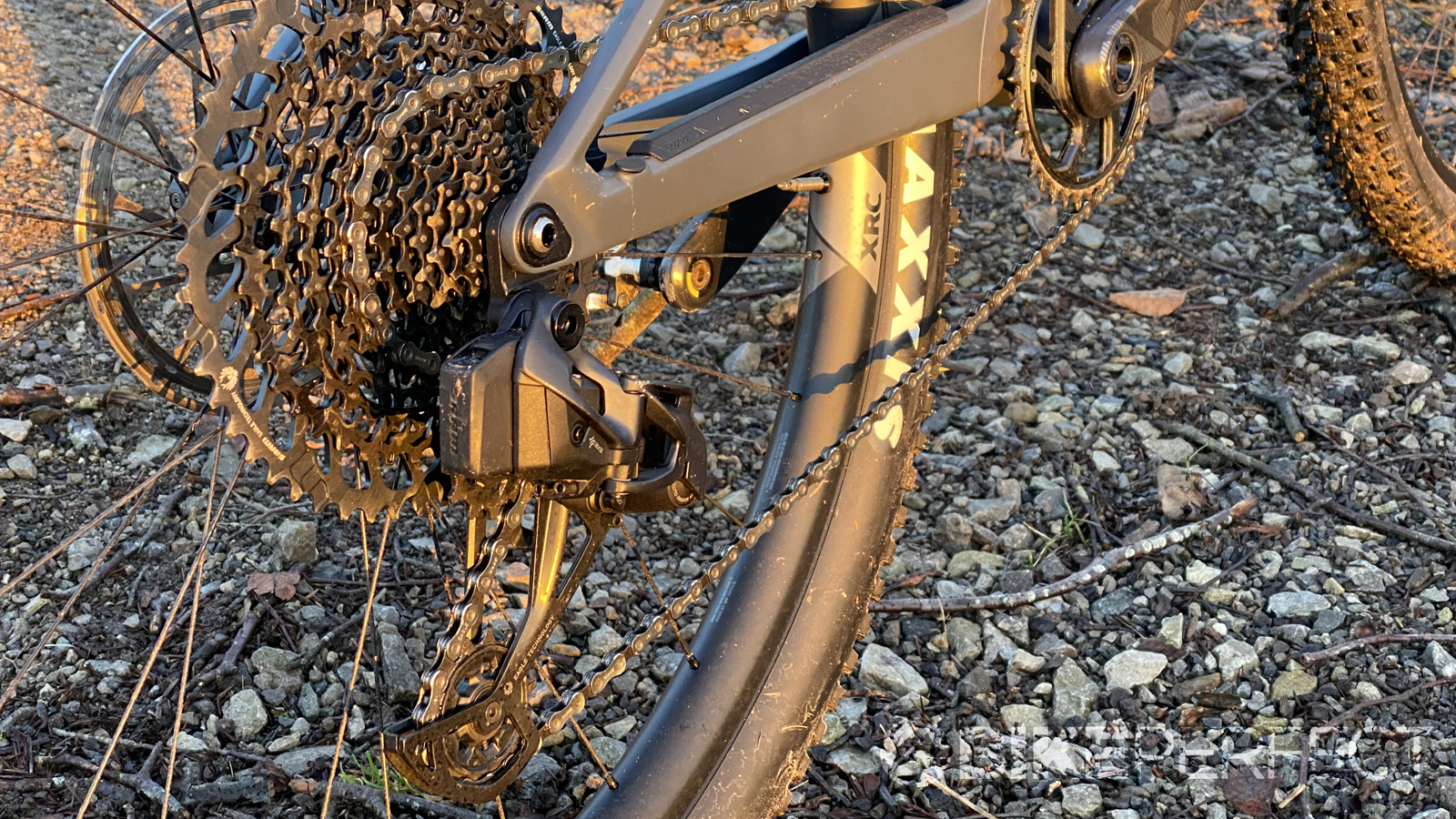
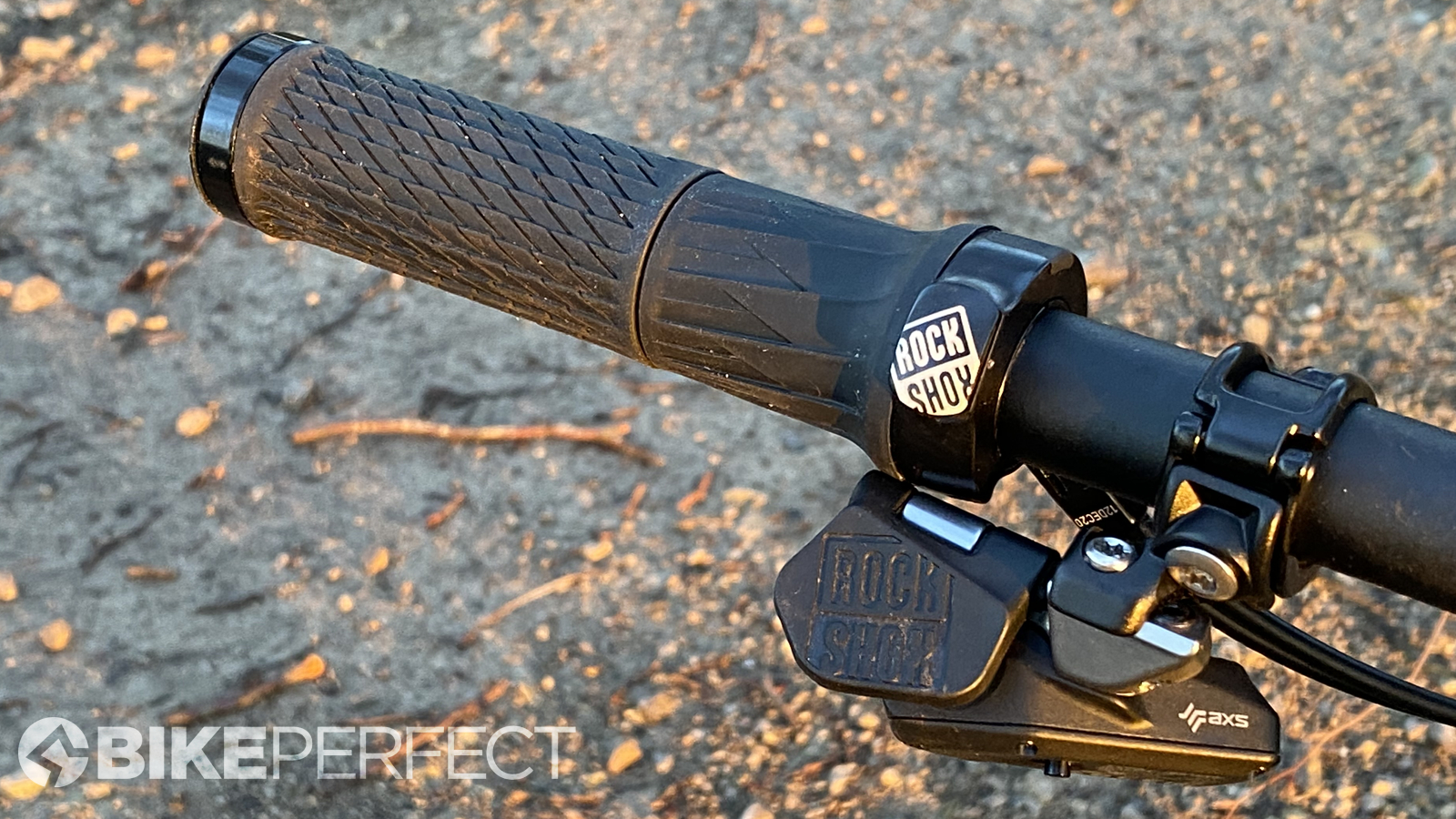
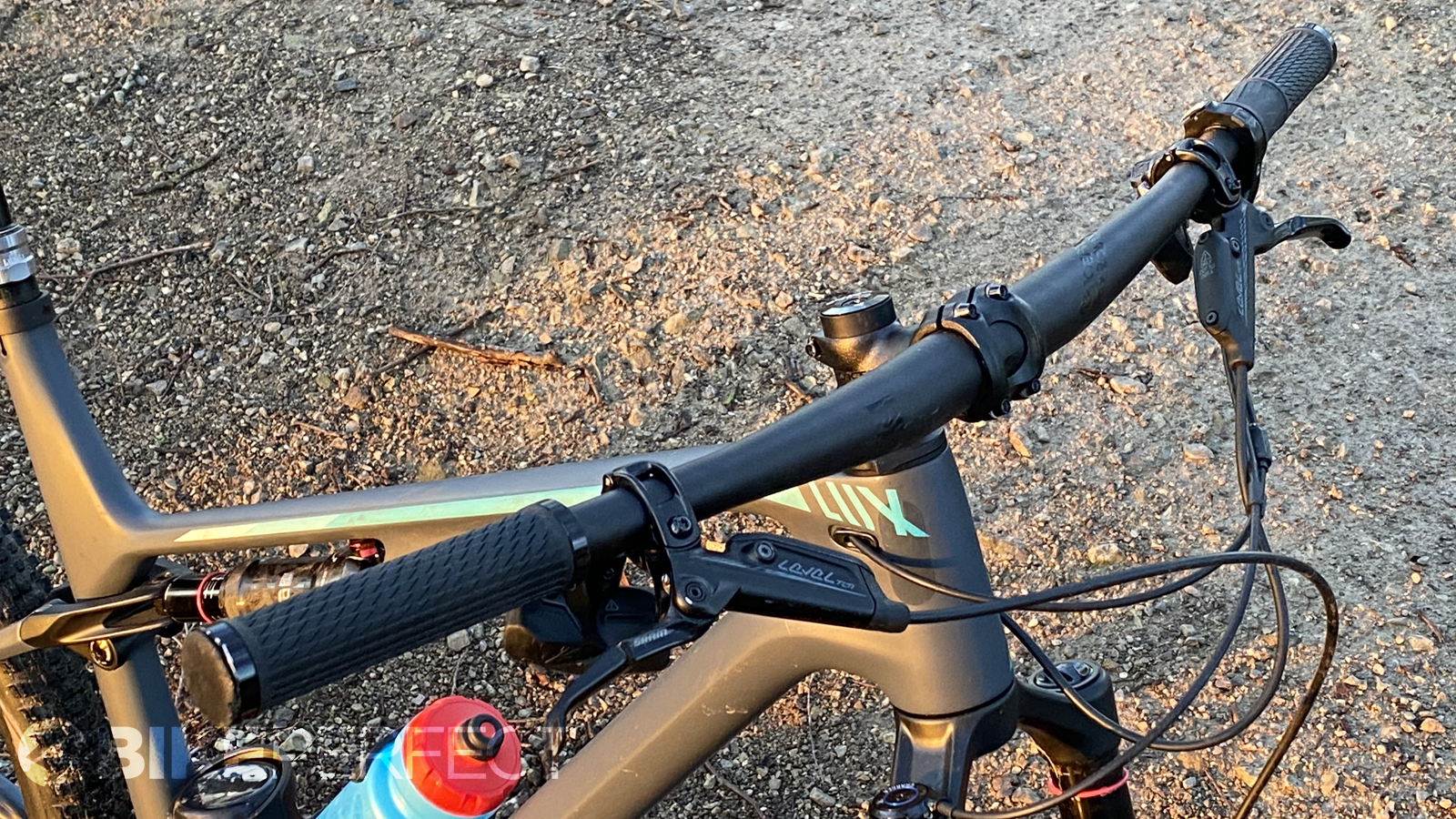
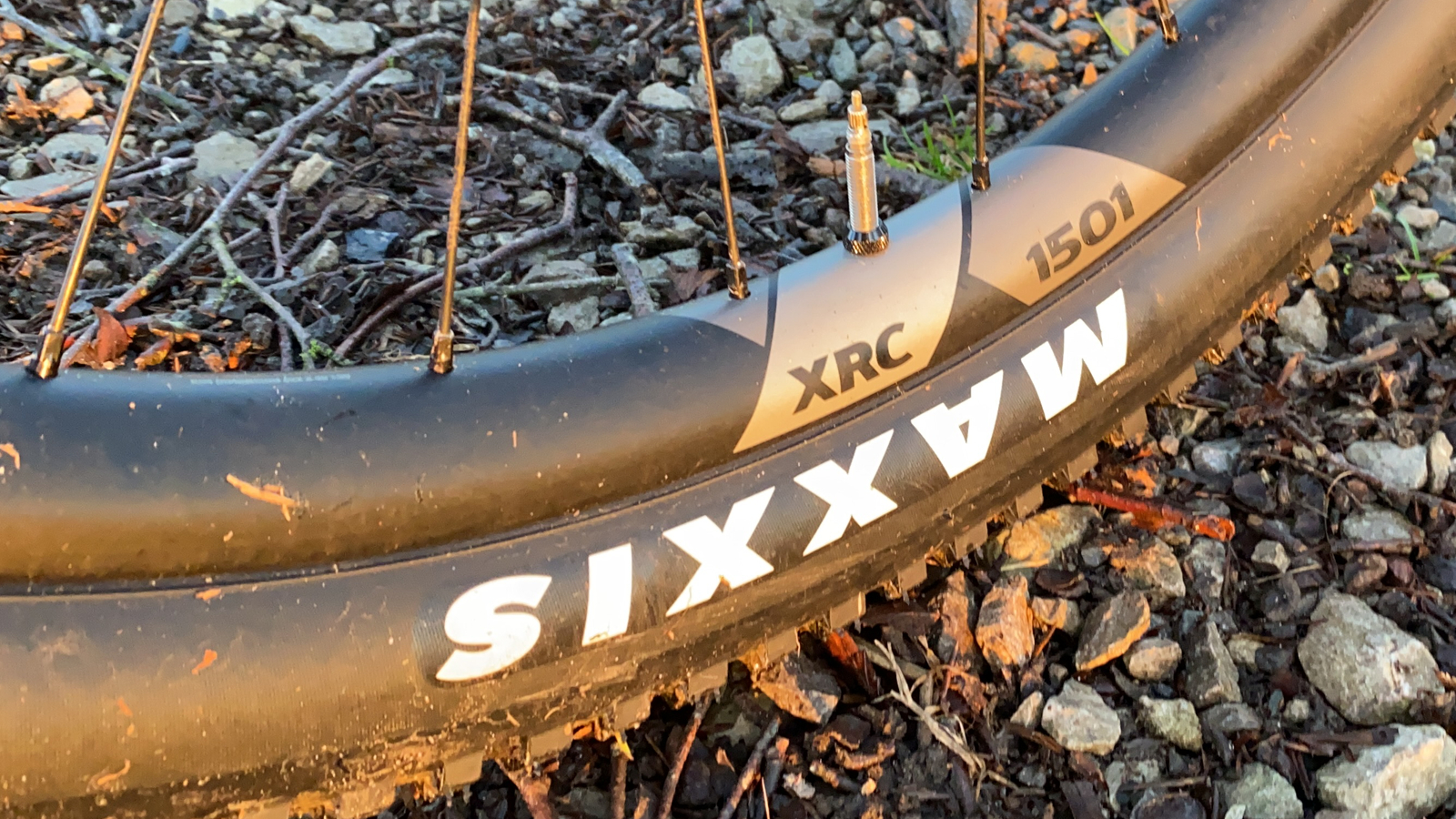
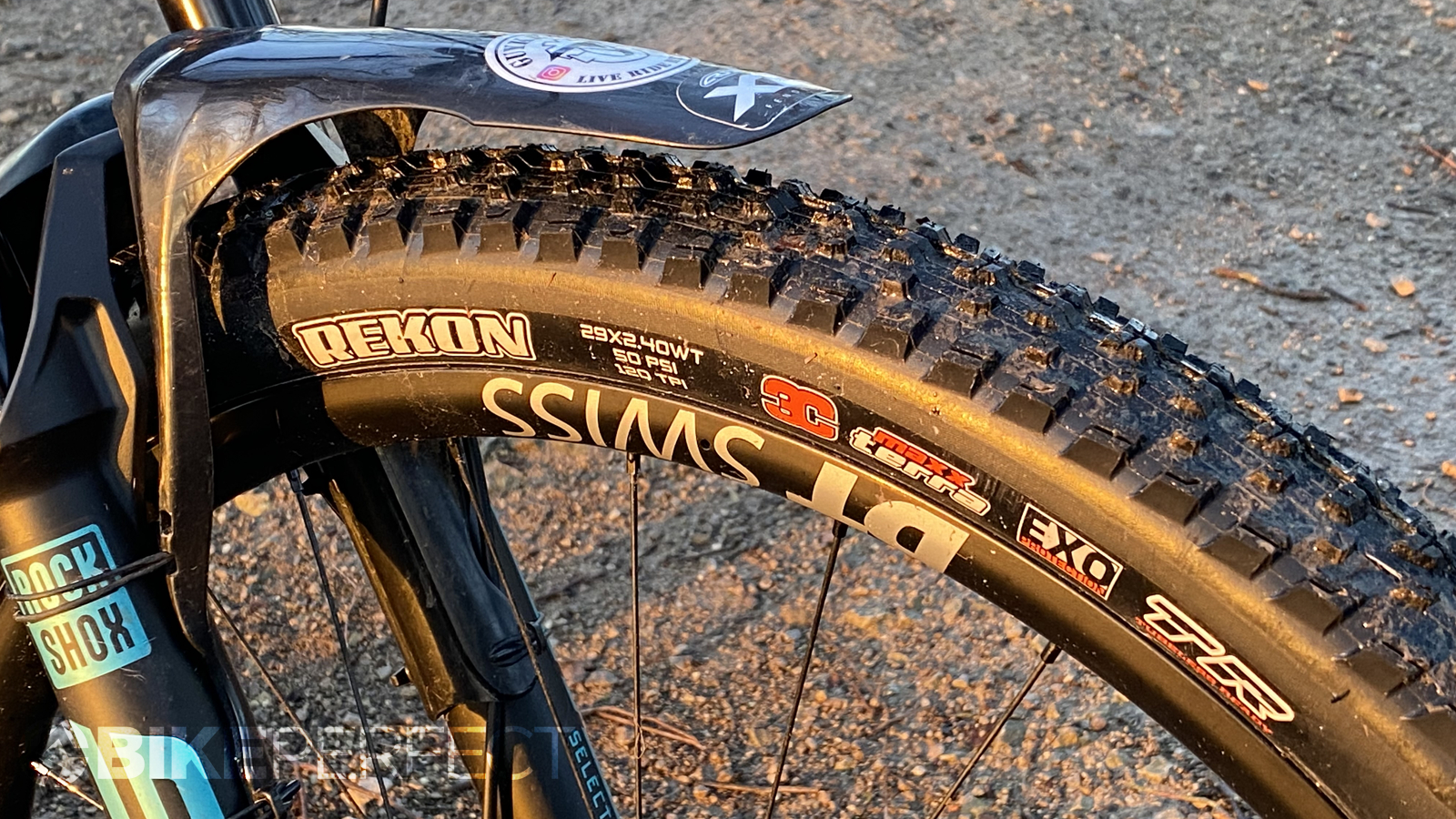
Performance
We need to talk about sizing straight away. Specifically the extended 508mm seat tube which even with a 125mm stroke dropper means a minimum seat height of around 740mm (Canyon say 743mm but there’s a bit more drop than that). That means more riders will have to size down to a medium (465mm seat tube) which with a 460mm reach would also work better with the same for all sizes 60mm stem length. Given that there seems to be no obvious structural reason the seat tube needs to tower so high above the sloped top tube we don’t know why Canyon hasn’t just shortened it as they have on the latest Neuron to give more fit options.
While it’s tempting to go for a long reach because that’s what most bikes are moving towards on XC, you need to realize that Canyon hasn’t compensated for that in the comparatively slack seat tube angle or stem selection either. That means while a 760mm bar, 60mm stem and 67.5-degree head angle work fine together in a ‘general purpose’ character, they’re way, way out in front of you. That’s OK for straight-line stability but makes the front tire feel very light on seated climbs. As a result, while the longer stem means it doesn’t wander around it lifts and skips too easily on tech terrain.
Rather than a steeper seat angle and slacker ahead angle centering you confidently in the heart of the action, the whole bike feels super stretched and unwieldy on tighter trails too. With the seat still high even when fully slammed it’s hard to hip swing it into turns and with what are basically road bike brakes doing the stopping, steep woodland twisties repeatedly ended with me hugging trees.
I got around this to some extent by fitting a 40mm stem and pushing the saddle as far forward on the rails as possible which made it more ‘body English’ responsive and let us put more load through the tires climbing and descending. With a 67.5-degree head angle that obviously makes it more of a twitchy handful on climbs though. Again that suggests staying old school XC and going with the smaller option of Canyon’s online sizing guide will likely suit the people who should buy a Lux Trail better.
While there are relatively simple workarounds to the fit/handling issues the suspension performance throws up more fundamental flaws. The basic problem is that the 55mm stroke for 110mm of travel (2:1 overall) shock leverage seems to be too low for the seal stiction and natural damper range of the shock. Combined with a flex stay – rather than pivoted – rear end, even with the lightest compression damping tune initial movement is massively stiff wherever you are in the stroke.
As a result, while we’d normally run an XC bike at 20-25 percent sag it still felt extremely wooden at 30 percent sag with 110psi for a 70kg rider. Compounding the problem once it does begrudgingly start to move, with the single volume spacer fitted as standard it blows straight through the travel. That means nothing tangible in the way of mid-stroke support for cornering or much in the way of impact control and I’d often look round startled to find the red travel ring right off the shock shaft wondering when that had happened or why.
To combat that I added a second spacer and dropped the pressure to 100psi (bearing in mind we normally run 150-200 depending on bike) but then we struggled to get full travel even hitting stuff really hard. Unsurprisingly given the very low pressures even with the rebound run fully open it still feels slow and prone to bogging down over sequential hits. Like the handling there is potential to help this by getting the shock retuned professionally and just switching to a lighter oil might help. I haven’t had to consider that sort of work on a test bike for about a decade though. The simpler Charger RL fork damper, metal collar ended grips and stiff 35mm alloy bars don’t do front end arm pump and fatigue levels any favors on longer, rougher descents either.
Considering how sorted the triple-phase suspension is on the Spectral and other contemporary Canyon trail/enduro/DH bikes this all means the Lux Trail really isn’t up to the benchmark standard we expect from the Koblenz crew. That’s even more relevant as the CF8 is only 800g lighter (Canyon’s figures) than the equivalent spec 140/130mm travel Neuron and 1400g lighter (our figures) than the Spectral CFR we recently tested. Not only is this really well-shaped with excellent suspension but rough calculations suggest that the 160mm Fox 36 fork, 150mm travel piggyback rear shock and 2.5in wide enduro tires add a combined weight of close on 1500g just in kit which is at odds with Canyon’s claimed frame weights for the bikes.
As a final blow, while the Maxxis tire combo gives a really fast roll when freewheeling that doesn’t fully translate across to the speed sensation of the Lux Trail under power. Obviously being able to fully lock the shock and fork remotely aids efficiency on smooth surfaces and it’s stiffer than the first generation Neuron (we’ve not tested the most recent one yet) but there’s definitely a sense of lost energy on a bike who’s heritage suggests that should be a strong point. Overall frame feel is numb rather than nuanced too so there’s no supple traction or comfort gains but no pinpoint precision either. Slow engagement from the DT Swiss hub can exacerbate the clunky nature of the suspension too, so it’s worth considering upgrading to the faster freehub driver ring.
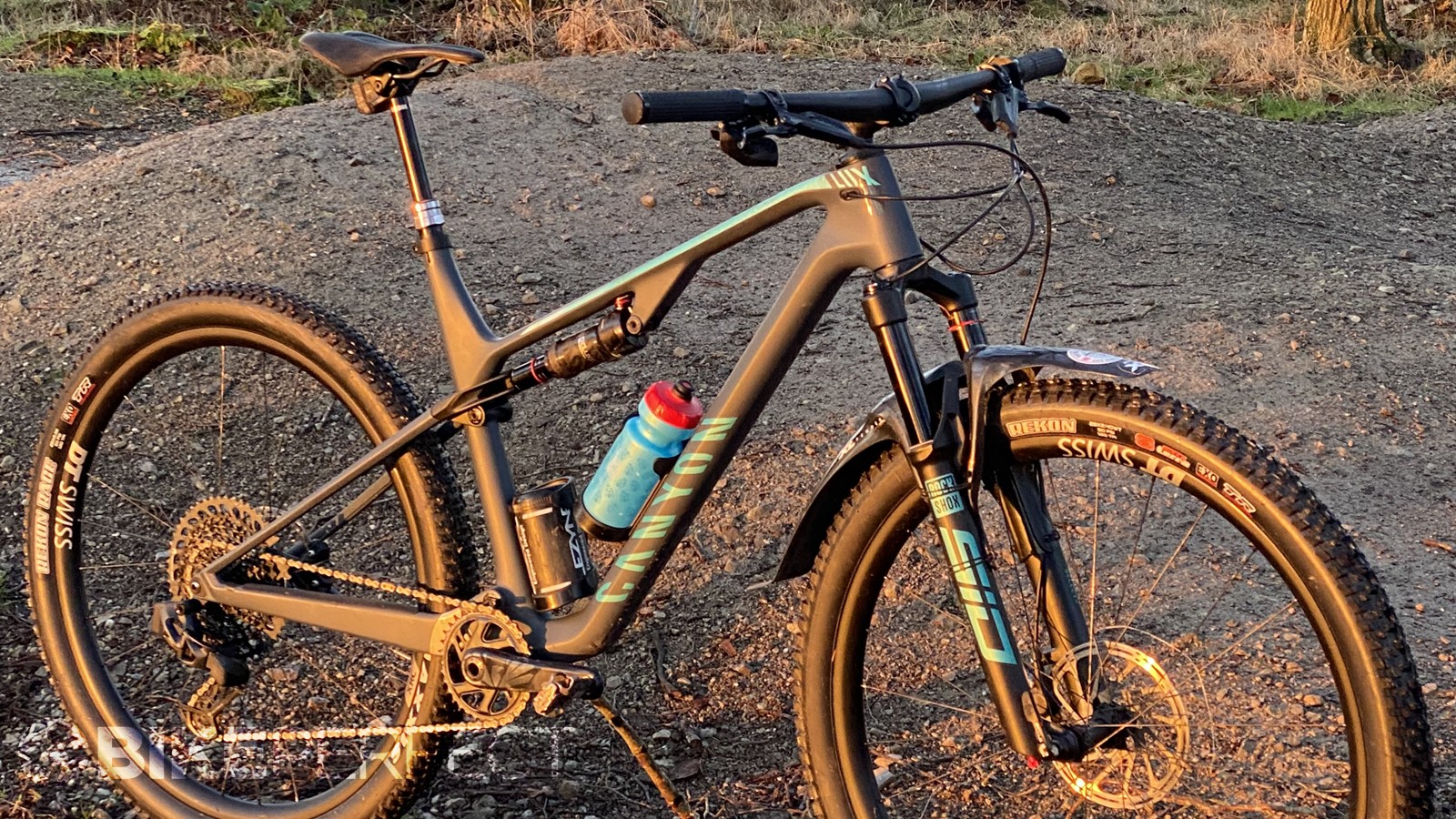
Verdict
If you’ve read this far it’s clear we’ve got some real issues with the Lux ‘Trail’ from the crossover ‘downcountry’ perspective that Canyon is pushing it under. The handling is unbalanced as standard, the seat tube is too tall and the suspension is so unresponsive we lost count of the number of times we pressed the release button on the remote thinking we’d accidentally locked it out without realizing. Overall weight is high considering the nervous tech trail vibe and low suspension control levels too. Even with a benchmark wheel and tire set up that flies when freewheeling it doesn’t feel as fast under power as we’d expect either.
In its defense, the component spec is amazing for the money and the two cheaper bikes are even better value in terms of performance for the price. There are some really nice features built into the frame too. It’s important to remember the ‘rigid or trapdoor’ suspension performance and straight-line handling (especially if you size down and stay ‘old school) are less likely to be an issue for the vast numbers of marathon riders of Canyon’s German home market.
However with so many brands producing brilliant bikes in this seriously fast but also massively fun segment right now the Lux Trail ultimately feels exactly what it is – an old XC bike back end bolted onto a longer front end – rather than a balanced, high speed, high control package.
Test conditions
- Temperature: -5 to 15 degrees
- Surface: Rocky red and black grade trail center, old school DH, new school berm stacks, fire road blasts and frozen/snowy moorland epics.
Tech Specs: Canyon Lux Trail CF8
- Price: $6,299 / £5,149
- Model: Canyon Lux Trail CF8
- Discipline: XC/Trail
- Head angle: 67.5-degrees
- Frame material: Canyon CF carbon fiber
- Size: Large
- Weight: 12.15kg
- Wheel size: 29 x 2.4/2.35in
- Suspension: RockShox SID Select+ Remote 120mm travel, 44mm offset/RockShox Deluxe Ultimate Remote 110mm travel
- Drivetrain: SRAM GX Eagle AXS wireless 12-speed gearing, shifter and SRAM GX Eagle 10-52T cassette and SRAM DUB Pressfit BB
- Cranks: Sram GX chainset, 34t
- Brakes: SRAM Level TLM brakes with 180/160mm rotors
- Cockpit: Race Face Ride 760mm flat bar and 60mm stem
- Wheelset: DT-Swiss XRC 1501 Spline 30mm carbon wheels
- Tires: Maxxis Rekon 3C Exo 29 x 2.4in front and Maxxis Rekon Race 3C Exo 2.4 29 x 2.35in rear tire
- Seatpost: RockShox Reverb AXS wireless 125mm stroke dropper post
- Saddle: Selle Italia SLR Boost saddle

Guy Kesteven has been working on Bike Perfect since its launch in 2019. He started writing and testing for bike mags in 1996. Since then he’s written several million words about several thousand test bikes and a ridiculous amount of riding gear. He’s also penned a handful of bike-related books and he reviews MTBs over on YouTube.
Current rides: Cervelo ZFS-5, Specialized Chisel, custom Nicolai enduro tandem, Landescape/Swallow custom gravel tandem
Height: 180cm
Weight: 69kg
